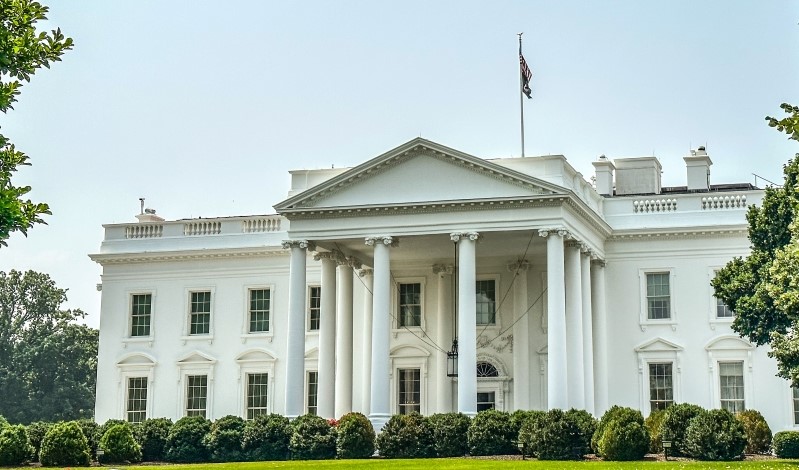
The Constitution’s Vesting Clause may not provide the broad grant of presidential power that some scholars have assumed.
The Vesting thesis is back in the news.
Aditya Bamzai and Saikrishna Prakash recently published an article in which they returned to their exchange with Andrea Katz and Noah Rosenblum last year in the Harvard Law Review about the President’s power to remove executive officials from office. The debate centers on the Vesting Clause in Article II of the U.S. Constitution, which states that “the executive Power shall be vested in a President of the United States of America.” The debate is primarily a historical one about which sources to rely on and how to interpret them in reconstructing Founding-era understandings of the meaning of “executive power.”
It is worth taking a step back from the historical discussion to appreciate the debate’s premises about how one ought to read the Constitution’s text.
Bamzai and Prakash take the view that Article II’s Vesting Clause confers a substantive power to appoint subordinates as part of the “executive power” that it grants. This view creates a puzzle. If the appointment power is part of the “executive power” that the Vesting Clause grants, then how do we make sense of the Appointments Clause?
The Appointments Clause, also in Article II, divides appointment power between the President, the Senate, and subordinate executive officials or judges—subject to congressional design choices. If appointment is an “executive power,” then the President does not possess all of the executive power. This conclusion casts doubt on the idea that reconstructing historical understandings of executive power can establish what powers the President possesses.
Bamzai and Prakash’s theory is that if a power is “executive,” then the President presumptively has it, unless another provision of Article II constricts the President’s power. In the case of appointment, although appointment is an executive power, the President’s appointment power is limited by the Appointments Clause. The Appointments Clause specifies the ways in which Congress can limit the President’s appointment power. But there is no Article II provision on removal. So, because removal is an executive power, the President has the removal power—and Congress cannot limit that power.
This approach renders the Vesting Clause redundant as a source of the appointment power. The Appointments Clause indicates what appointment power the Constitution grants the President. It does not matter whether it is an “executive power.”
In fact, Article II contains specific provisions on most of the powers that Bamzai and Prakash understand to be part of the “executive power,” notably powers concerning diplomacy—the Treaty power and the power to appoint ambassadors and consuls—and defense—the President’s status as Commander in Chief of the military.
Moreover, given that the appointment and removal powers are closely connected—indeed, the removal power is traditionally inferred from the appointment power—the Constitution’s concrete specification of the appointment power should be understood to have implications for the removal power. For an implicit statement about the removal power, the Appointments Clause seems more fertile than the Vesting Clause.
The more striking aspect of Bamzai and Prakash’s premise is that it seems inimical to the conventional understanding of the Constitution as creating a government of limited and enumerated powers. It also contradicts common sense to suppose that the scope of a power is broader by virtue of the fact that the power is unmentioned. The Constitution speaks precisely about the President’s appointment power. It says nothing about the removal power. Yet according to Bamzai and Prakash, that is precisely why the Constitution confers the removal power more forcefully.
In addition to being unintuitive, imputing unenumerated presidential powers could be dangerous. If the President presumptively has any power that is “executive,” then the risks flagged by the Trump v. United States dissenters become salient. Is assassinating a rival an exercise of “executive power”? Nothing in Article II says the President cannot do it. This seems like a powerful reason to resist the importation of unenumerated presidential powers on the grounds that they are “executive” in nature.
Granted, Bamzai and Prakash here are only talking about the removal power. Yet if removal were the sole power conferred by the Vesting Clause, that would be all the more puzzling. Why then not simply provide an express power of removal? Speaking clearly about the existence of a removal power would have done much to prevent confusion. If the purpose of the Vesting Clause really had been to confer a removal power, then the drafters could have accomplished their goal far more effectively with little additional effort.
Indeed, far smaller presidential powers are enumerated. The most instructive is the President’s power to “require the Opinion, in writing, of the principal Officer in each of the executive Departments, upon any Subject relating to the Duties of their respective Offices.”
The Opinion Clause perhaps does the most of any constitutional provision to refute the idea that the President possesses an unlimitable removal power. Indeed, the Opinion Clause implicitly assumes the potential absence of a presidential removal power. It would otherwise be nugatory—if the President could fire a subordinate, surely the President could also induce them to provide information in writing.
The Opinion Clause also makes clear that Congress cannot prevent the President from gathering certain information from principal officers. Applying a common principle of legal interpretation, expressio unius est exclusio alterius, the Opinion Clause implicitly indicates that with respect to other decisions about structuring the executive branch—including to what extent officials are insulated from presidential removal—Congress has more discretion.
Recent debate over the unitary executive theory—and the interpretation of the Vesting Clause on which it rests—has focused overwhelmingly on historical understandings of the executive power. Scholars on both sides of the question have largely assumed that it is appropriate to read the Vesting Clause as a source of unenumerated powers, prompting a search for historical evidence about what particular content belongs on this list.
But textual considerations render the core premise of this approach implausible. Thus, there is no need to search outside the four corners of the constitutional text for the substance of whatever “executive power” the Constitution confers. The Constitution does a lot to empower the President, but the Vesting Clause is not the place to look to understand how.




